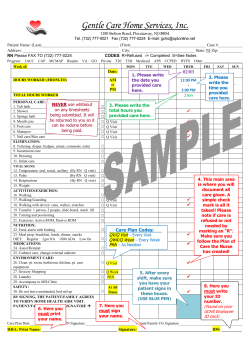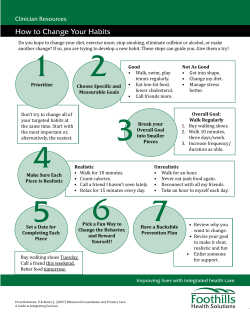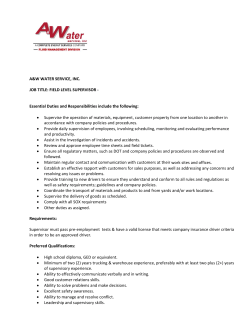
Go the extra mile! - Ministry of Health Promotion
Go the extra mile! ontario.ca/pedometerchallenge Enjoy the many benefits of walking Walking is one of the simplest and most natural forms of exercise, and can be incorporated into your daily life more easily than any other activity. No wonder it is Ontario’s most popular physical activity. Health experts agree that walking briskly for 30 minutes a day can improve your overall fitness, health and mental well-being. Here are some specific benefits: • Walking refreshes the mind, reduces fatigue and increases energy. • More than half of the body’s muscles are designed for walking; it’s a natural movement that is virtually injury-free. • Walking provides an enjoyable time for sharing and socializing with friends or family. • Regular, brisk walking can help prevent, minimize the risk of, or control type 2 diabetes, heart disease, hypertension, obesity and many forms of cancer. • Walking strengthens bones and can help prevent or control osteoporosis (a condition where bones become brittle and fragile). • Walking relieves stress and tension. • Regular walking will help you maintain a healthy weight and a positive body image, especially when combined with healthy eating. • Brisk walking trains your heart, lungs and muscles to work more efficiently. 2 Stepping out A minimum of 30 minutes of brisk walking daily is far better than the occasional weekend bout of frenzied activity. The Public Health Agency of Canada recommends 30 to 60 minutes of moderate activity most days of the week. Always consult your physician before starting an exercise program. Explore a variety of routes and choose ones that are interesting, safe and convenient. You may want to avoid heavy traffic, rough terrain and areas where dogs are not on-leash. Walk with others – it can be more motivating than walking alone. Join a walking club: contact your local YMCA or YWCA, municipal recreation department or public health unit to find a group, or visit the Walking section on ontario.ca/pedometer challenge for ideas on groups. Ask a neighbour or family member to join you. Walk safely. Don’t wear headphones in downtown t raffic or in areas where you need to be constantly alert. At night, walk with a friend and wear reflective tape on your clothing or wear clothing that is easily visible. Carry identification and a cell phone (or change for a phone call). 3 Choose the right walking shoes. When you walk, your feet hit the ground more than 1,000 times each kilometre, so comfortable socks and well-designed walking or jogging shoes are a must. Shop for walking shoes at the end of the day, when your feet may be slightly swollen. Try on both shoes and walk around in the store before buying them. Stay hydrated. In hot weather, choose a shaded route and walk a little slower than usual. Drink some cool water before you leave and bring water with you, especially if there is no water fountain en route. Avoid the hot sun and wear a hat and sunscreen. When it is cold, avoid icy surfaces and walk in places where you are shielded from the wind. Many people enjoy a “mall” walk at a local shopping centre in cold weather. And remember, you need water in the winter, as much as you do in the summer. Make sure you bring a water bottle along (drinking fountains may be turned off). Dress for the weather in loose, comfortable clothing made of soft fabrics such as cotton, wool or breathable nylon. In cold weather, be aware of the wind-chill factor. Dress in layers so you can peel off or put on clothing according to how warm you feel. Wear mittens, and cover your head and ears with a hat. 4 Design your own walking program Design your walking program by gradually increasing the frequency, time and distance. Here are some more helpful tips: • Walk briskly at a pace you can maintain comfortably. Slow down if you are unable to talk. Stop if you experience dizziness, pain or shortness of breath. • Create your own stride style. Breathe normally and let your arms swing naturally. • If weight loss is your goal, aim to increase to a 60–90-minute walk at a moderate pace, five to seven times a week. Distance and regularity are the keys to burning calories. To increase the number of steps you take every day, here are some helpful tips: • Walk part way or all the way home from work or school. • Walk to do your errands. • Take the stairs instead of an elevator or escalator. • Walk around the block during lunchtime. • Walk your dog or offer to take your neighbour’s dog out from time to time. Increase the intensity of your walks: • Speed walk – Breathe normally and pump your arms as you speed up your pace. • Climb walk – Climbing hills or stairs is an extra challenge on the abdominal, buttock, lower back and leg muscles, so add some exercises and stretches to your warm-up to target these muscles. Increase your climbing gradually. • Water walk – Even though walking in water adds resistance so your muscles work harder, it is easy on the joints and cool in hot weather! 5 Count your steps to better health Here are a few guidelines that can help make every step count: Use a pedometer: A pedometer counts the number of steps you take. You can find them in many sporting goods and department stores. Find your baseline: Clip the pedometer on your hip and set it to zero. Go about your daily routine and record the number of steps you have taken at the end of the day. Do this for seven days. At the end of the week, calculate your daily average by dividing the total number of steps for the entire week by seven. That number will be your baseline to work on the following: • Increase your number of daily steps by 500 each week. For example, if your baseline is 3,000 steps a day in week #1, your goal for week #2 would be 3,500 steps a day. For week #3, it would be 4,000 steps a day. • Once you reach your 10,000 steps a day goal, reward yourself, tell your friends and then make a commitment to keep it up. Keep a weekly walking log: Monitor your progress in a journal or use the online Step Tracker in the Walking section on ontario.ca/pedometerchallenge. If you don’t have a pedometer, make a commitment to walk a minimum of 30 minutes every day. 6 Your daily score: Less than 5,000 steps a day means you are not getting enough physical activity; 5,000–7,499 steps a day is about average for most people, but is not enough to enjoy all the health benefits of walking; 7,500–9,999 steps a day is moving in the right direction and puts you in the “somewhat active” category; More than 10,000 steps a day is a good target and puts you in the “active” category; More than 12,500 steps a day puts you in the “highly active” category and ensures you are enjoying many health benefits. 7 Add stretches to your walking program Be sure to warm up with five minutes of medium-paced walking, followed by some stretches for your legs. To prevent stiffness and increase flexibility, here are some stretching tips for warming up and cooling down: • Calf muscles stretch: Stand facing a wall. Position your forward foot approximately 30 cm from the wall. Stretch your arms forward, elbows straight and lean against the wall. Place your other foot a few inches behind and to the side of the front foot and slowly plant it flat on the floor. Lean forward until you feel a stretch in the calf of your back leg. Hold for 15–30 seconds. Relax and repeat twice for each leg. 8 • Hamstring muscles stretch: Sitting on the floor, put one leg straight out and the other leg bent at the knee. Keeping your back straight, lean forward, sliding your hands down the straight leg until you feel a stretch. Hold for 15–30 seconds. Relax and repeat twice for each leg. • Thigh stretch – sitting: Sit on the edge of a chair. Lower your knee toward the floor and press it back under the chair. Hold the stretch for 15–20 seconds. Repeat twice for each leg. 9 • Alternate thigh muscles stretch: Stand close to a wall and place one hand on it. With the other hand reach back and hold the same side foot in that hand. When balanced, begin to slowly raise the heel up towards your buttock. Hold for 15–30 seconds. Relax and repeat twice for each leg. • Achilles stretch: Sitting on a chair, plant one heel on the floor and gently lift your toes up towards the ceiling as far as you can. Hold for a count of five, then relax. Repeat for each foot several times. 10 Total Saturday Friday Thursday Wednesday Tuesday Monday Sunday Day Week Walking Log 11 Time Steps km Speed The Province of Ontario is committed to increasing participation in sport and physical activity, so all Ontarians can enjoy the health benefits of activities like walking. © Queen’s Printer for Ontario, 2010 Published by the Ministry of Health Promotion ISBN 978-1-4249-5176-5 (Print) ISBN 978-1-4249-5177-2 (PDF) ISBN 978-1-4249-5178-9 (HTML) ontario.ca/pedometerchallenge
© Copyright 2025









